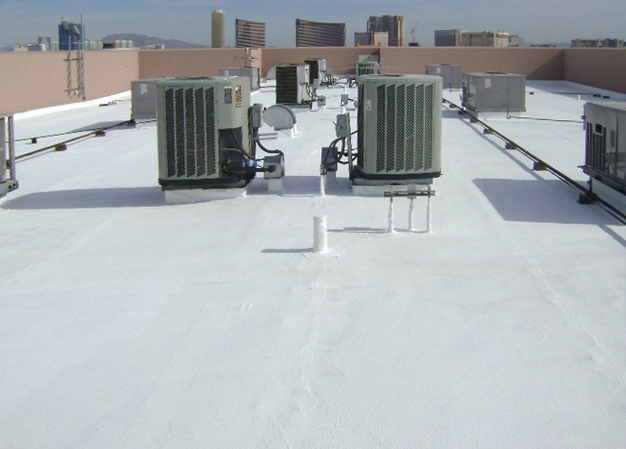Energy Efficient Roofing Options for Industrial Facilities
When it comes to selecting a roof for your facility, there are many standard industrial roof types that come to mind. This includes metal, Ethylene Propylene Diene Monomer (EPDM), single-ply, foam, built-up tar and gravel, rubber, PO, flat, shingle, and a variety of coatings. But what if you want to install an energy-efficient roof that will help reduce your facility’s energy use as well?

What makes a roof energy efficient? According to EcoWatch, an environmental news leader, the properties that make a roof energy efficient include the material, color, coating, and thermal mass of the roofing material. The design of your roof, the insulation, and the ventilation systems in the attic (if your facility has one), can all have an impact. There are two main factors to consider when designing your roof.
Solar Reflectance Index (SRI)
The design and material of your roof will determine its solar reflectance index (SRI) which is expressed in the percentage of sunlight reflected by the roof. The higher the SRI, the more energy-efficient your facility will be. SRI is considered the first and single most crucial factor in determining how hot your roof will get. According to the Environmental Protection Agency (EPA), a cool roof can stay cooler than a traditional roof by 50 degrees Fahrenheit or more.
Proper Attic Ventilation and Roofing Insulation
The second factor is the attic ventilation and roofing insulation. Building standards have improved immensely over the years, and better building techniques and energy-efficient windows and doors have sealed off industrial facilities from the outside world. The downside is that this can result in condensation building up in attic spaces and lead to water damage. If your facility has an attic, proper ventilation and insulation are crucial. Sufficient airflow from your roof and tightly installed insulation can keep your facility energy efficient without incurring water damage.
Once you have considered your facility’s SRI and ensured you have the proper roofing insulation and ventilation (especially if you have an attic), consider all the energy-efficient roofing options. Selecting the right roof for your facility will reduce your company’s energy costs and improve sustainability. Some of the most popular and energy-efficient roof options include the following:
Cool Roofs
Commercial cool roofs are designed to reflect more sunlight and absorb less heat than standard roofs. This is achieved with reflective coatings, which can include reflective paint or the application of single-ply membranes to an existing roof. Reflective shingles and tiles with inherent reflective properties can also be effective.
Metal Roofs
Metal roofs are durable and can be coated with a metal roofing coating, which is a reflective material that enhances energy efficiency. A study funded by the U.S. Department of Energy and conducted by the Oak Ridge National Laboratory in Tennessee showed that metal roofs promote energy conservation depending upon how the roof is properly installed.
In the study, a metal roofing was attached with a batten/counter-batten system that allowed for airflow underneath the metal roof. Researchers found a 45 percent decrease in the flow of heat with the metal roof, mostly because of the ventilation above the sheathing. Researchers also found an up to 25 percent reduction in cooling costs. Conversely, when a roof is nailed directly to a roof deck with no air space below, which causes greater heat loss occurs in the winter. Having an air gap acts like insulation, preventing heat transfer out of your facility. Likewise, in the summer, an air gap prevents the heat of the sun from warming up the area directly below the roof and the rest of the facility.
Insulated Roof Panels
Insulated roof panels have built-in insulation, offering superior thermal performance. Structural Insulated Panels (SIPs) are prefabricated panels with a foam core sandwiched between two structural facings. Insulated Metal Panels are similar to SIPs, they have more strength and durability.
Thermoplastic Olefin & Polyvinyl Chloride Roofing (TPO, PVC)
Thermoplastic Olefin (TPO) & Polyvinyl Chloride (PVC) roofing consists of single-ply roof membranes that are both reflective and durable. Thermoplastic roof coatings offer high reflectivity and resistance to ultraviolet, chemical, and biological degradation, while PVC roof coatings are known for their durability and resistance to chemicals and fire.
Built-Up Roofing with Reflective Coating (BUR)
A Built-Up Roof (BUR) system consists of multiple layers of bitumen and reinforcing fabrics, which provide excellent thermal insulation and reduce the need for heating in the winter and cooling in the summer. This system can be enhanced by applying a reflective coating to the top layer to improve energy efficiency and reduce heat absorption.
EPDM Roofing (EPDM)
EPDM is a durable, synthetic rubber roofing membrane that can be made more energy efficient. When seeking a “cool roofing” option, many building professionals are not aware that black EPDM provides similar energy savings to white, non-EPDM counterparts. However, a white EPDM membrane can enhance reflectivity compared to traditional black EPDM.
Green Roofs
Green roofs, also known as living roofs, are partially or completely covered with vegetation. The benefits of installing this type of roof include thermal insulation, since the plants and soil provide natural insulation and reduce cooling and heating needs; stormwater management, because the plants absorb rainwater and reduce runoff; and improved air quality, since plants filter air pollutants.
Since there are many energy-efficient commercial building roof types to consider, consult with a roofing expert like Capital Roof Care. They will help you understand things like:
- Climate: Your local climate will influence which roofing option is most suitable
- Cost: Initial installation costs versus long-term energy savings
- Durability: The lifespan and maintenance requirements of the roofing material
- Building Structure: The existing structure’s ability to support the roofing system
No matter what type of energy-efficient roof you choose, your investment will save your facility money and make it more sustainable.
Sources:
https://www.ecowatch.com/roofing/roof-energy-efficiency